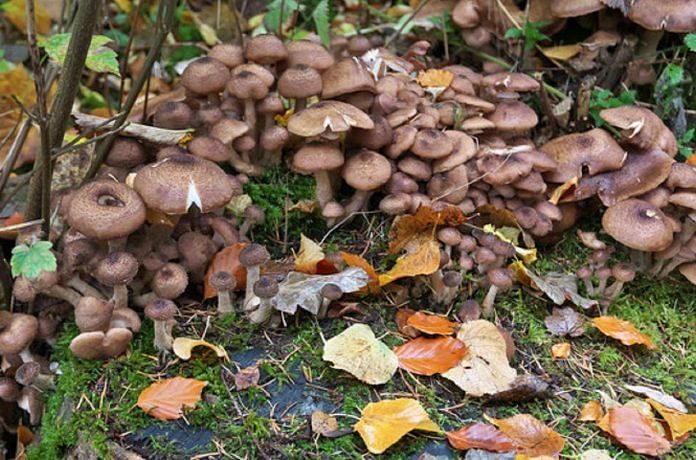Sex: birds do it, bees do it – and fungi do it too. Here’s how, and why it matters.
Sex is an essential part of life. You, me and almost every other living organism on this planet are only here because two individuals got together at some point in the past to have their genes represented in the next generation.
For many species on earth – especially humans – that’s a pretty inflexible process. There are strict requirements: for instance, having two partners of the opposite sex tends to be indispensable for the production of offspring.
But there are a number of exceptions to this rigidity. Some of the most beautiful and interesting are exemplified by certain species of fungi.
Fungi play a variety of roles in our lives. Some are food sources, like button mushrooms; some are used in the production of cheese, wine, beer and bread. Others have provided humans with antibiotics for almost a century. And still others can cause great harm, wiping out trees by the hectare – or even killing humans.
And of course, like most species, fungi have sex lives. I study the sexual behaviour of Huntiella moniliformis, a sweet-smelling and fluffy white fungus that’s found in plantations all over the world. It’s fairly unique in that it’s unisexual – able to reproduce completely alone.
This makes it potentially very dangerous: even if it’s the only fungus in, say, an entire forest, it can keep mating and reproducing. It gets all the evolutionary benefits of sex, without having to go through all the trouble of finding a mating partner.
If we understand its sex life, we can come up with ways to control, manage or even stop it. That’s important in the case of species like Huntiella moniliformis, because they can infect damaged trees and cause disease.
Fungal mating strategies
In humans and most other mammals there is only one way to produce sexual offspring: sexual intercourse between a male and a female. Reptiles and birds often also reproduce heterosexually.
Fungi, meanwhile, can utilise one or more of six different sexual strategies. These range from the fungal equivalent of heterosexuality to changing their mating type as necessary.
Heterothallism: is like heterosexuality in humans and requires two partners. In humans, having two X chromosomes makes you female; having an X and a Y chromosome makes you male. Some fungi use a similar system but instead of a whole chromosome they use single genes. A fungus with the MAT1 gene is of the MAT1 mating type; having the MAT2 gene means its mating type is MAT2.
For sex to take place, MAT1 and MAT2 partners need to get together. This means that out of everyone you meet, only half are sexually compatible with you. This severely limits the number of successful partners a fungus can meet in its search for a mate.
So how do they find each other? Smell. Or, at least, something similar: pheromones. These are small molecules that let a MAT1 individual know that a MAT2 individual is close, and vice versa. This ensures that no one wastes time and energy slowly growing towards an incompatible partner.
Primary homothallism: is when a single fungus has sex completely alone. Instead of having either the MAT1 or the MAT2 gene, they have both. In this way a single individual can make both pheromones and recognise itself as a partner. There are other forms of self-sex too. Two of these include the ability to change mating type. These systems mimic those of some fish that can switch between male and female, depending on what partners are available. The third relies on having two genomes and is functionally very similar to heterothallism.
The fourth lonely sexual strategy completely changed the way we think about sex in fungi. Unisexuality occurs in individuals we would classically have thought to be either MAT1 or MAT2. We would have expected them to need a partner, but they don’t.
My PhD research at the Forestry and Agricultural Biotechnology Institute in South Africa has revealed that unisexual reproduction is possible in H. moniliformis. My supervisors and I have recently shown that MAT2 individuals are able to secrete both pheromones, despite the absence of the MAT1 gene.
This means that a single mating type can recognise itself as a compatible partner and respond appropriately. We are currently working on understanding how this system evolved and whether related species could be manipulated to employ the same strategy.
Why does this matter?
There are obvious evolutionary benefits to species having sex. The most obvious is because it ensures a species’ longevity. But there are downsides – not for H. moniliformis, in this case, but for forestry plantations.
Sex combines genes from different individuals and produces genetically unique offspring. In disease causing fungi this has been shown to enable host jumping – the movement from a susceptible host species such as a Pine tree in a plantation, to a previously resistant species, like an indigenous tree in a natural forest.
This means that hosts previously thought to be immune to infection could get infected in the future, and can cause serious disease outbreaks that are difficult to control.
The other downside to sex in fungi like H. moniliformis is that it produces easily dispersible spores. These are often the agent that enhances fungal spread and infection.
Understanding these processes, and the sex lives of fungi like H. moniliformis, can help us find answers to how to control the spread of diseases. This will ultimately mean keeping plantations – and humans – safer.
Andi Wilson is a PhD scholar at the University of Pretoria.
This article was originally published on The Conversation. Read the original article.



